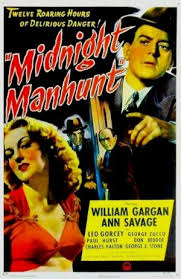
“I figured this whole thing out by the process of mental reduction.”
Joe Wells (George E. Stone) is a gangster. He’s on the run from the law and hiding out in a cheap hotel room. A knock on the door proves to be a man named Jelke (George Zucco). Jelke shoots Wells and takes a package off the body. He then quietly leaves. Wells is not quite dead. He staggers out of the hotel.
Murphy the cop (Paul Hurst) finds the body of Joe Wells outside a wax museum. He calls it in. When he goes back the body is gone. Reporter Sue Gallagher (Ann Savage) lives above the wax museum. Before she goes home she stops in to see the museum owner Henry Miggs (Charles Halton) and his handyman Clutch Tracy (Leo Gorcey). She hears about Murphy’s found and lost corpse. Sue works for the Chronicle and she feels she is not getting any respect at the paper. She fantasizes about getting a scoop on Wells. She says goodnight and heads upstairs.
On the stairway she finds Wells’ body. She decides to hide the body among the wax figures in the museum. This will give her time to get a photographer and her scoop. Clutch calls Pete Willis (William Gargan), a former love interest and fellow reporter of Sue’s. He tells Pete about Murphy’s missing corpse. Pete comes down to the museum to see what’s up. Henry finds the corpse and wants to call the police. Clutch convinces him that it would look bad for the museum. They would be suspects. Clutch says they need to move the body away from the museum.
In the meantime Jelke wants Wells’ body back. He’s got a long range plan and part of it entails making sure that Wells’ body is never again seen. Anyone in his way won’t be for long.
Things don’t get any better from here. Now it’s body, body, who’s got the body. Adding to the shenanigans is a $5,000 reward for Wells, dead or alive, and some stolen South American diamonds.
“Midnight Manhunt” was released in 1945 and was directed by William C. Thomas. The movie was produced by Pine-Thomas Productions. They were a “B” movie unit of Paramount Pictures. The company produced some 81 or so movies, most of them for Paramount, between 1940 and the late 1950’s. All of them were low budget deals that made money. William H. Pine and William C. Thomas were nicked named “The Dollar Bills” because none of their movies ever lost money. Sort of the Roger Cormans of their time. They are quoted as saying "We don't want to make million dollar pictures. We just want to make a million dollars."
The movie is a comedy with a little mystery added in. The mystery isn’t in who-done-it? We know that from the first frame of the movie. The mystery is more akin to a game of hide-and-go-seek.
It’s very light and silly. All the characters are comic relief. Well, except Zucco. Not to say that Zucco can’t be funny, but somebody had to be the bad guy and he can do that too. This is 40’s style screwball comedy. Nothing about it is to be taken seriously.

